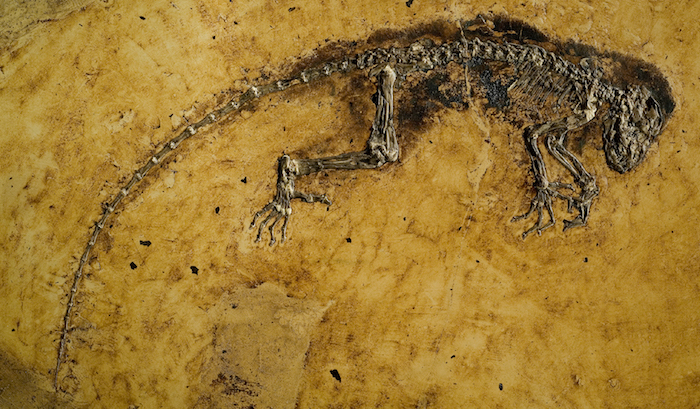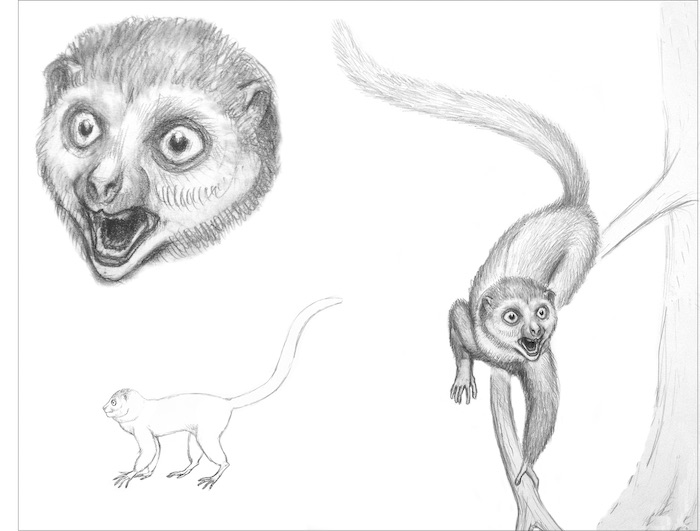In 2009, the Natural History Museum at the University of Oslo announced the discovery of a new fossil of an ancient, extinct primate. The discovery was published in a normal peer-reviewed scientific journal, but was accompanied by the simultaneous release of a book and a documentary. These, like the press conference (but unlike the paper) touted the fossil as a ‘missing link’ that answered foundational questions about human evolution. The press went wild with the news. So did primatologists, but for different reasons. Many of the museum’s claims in the press didn’t line up with their scientific paper. It seemed the museum was misleading the public – perhaps intentionally – to boost its own prestige. Let’s look at this tempest in a teapot, and see how we can adapt it to an RPG context!
This post is brought to you by beloved Patreon backer Arthur Brown. Thanks for helping keep the lights on! If you want to help keep this blog going alongside Arthur, head over to the Patreon page – and thank you!

The fossil was of a never-before-seen species named Darwinius masillae, but everyone called her Ida. She was about two feet long, with a furry coat, a raccoon-like snout, opposable thumbs and toes, and all the features of a proper primate. She looked a lot like a lemur, though she definitely wasn’t one. Ida lived 47 million years ago in a sub-tropical forest in what is today Germany. Her fossil is incredibly well-preserved, down to the remnants of old wounds. She’s a remarkable find from an era of primate evolution about which we know little.
This marvelous fossil sheds light on a longstanding conundrum in primatology: where do a set of creatures called ‘tarsiers’ fit on the primate family tree? Monkeys, apes, and humans are all closely related to one another. Lemurs, lorises, and bushbabies likewise form a closely-related group. But the little family known as the tarsiers doesn’t fit neatly into either. These tiny insectivores share traits with both groups. The question isn’t which group the tarsiers belong to (the answer is neither), but which they are more closely related to. DNA evidence suggests they’re closer to monkeys, apes, and humans, but it would be nice to corroborate that with some fossil evidence. As Ida seems to fall somewhere around where the two main primate groups diverged, she’s a handy data point for resolving the tarsier conundrum.
That wasn’t enough for the Oslo Natural History Museum. They wanted a Mona Lisa – something that would put them at the same level of prestige as the Louvre. So when they went public with the discovery, they billed Ida not as a data point, but as the entire solution. They claimed (without much evidence) that Darwinius masillae wasn’t close to the branching point, but actually was the branching point. Furthermore, the museum knew that few laypeople would care about the fairly obscure tarsier dispute. Instead, they billed Ida as a missing link in human evolution, pairing her 47-million-year-old bones in the minds of the public with those of the Australopithecus Lucy, from 3.2 million years ago. It’s technically correct, but if Ida is a missing link (she’s probably not), she’s just as much a missing link for tarsiers, lemurs, and spider monkeys as she is for humans.

Image credit: Cgaa. Released under a CC BY-SA 3.0 license.
Ida’s provenance is also unusual. She was excavated in secret, prepared for permanent storage and display by an unidentified member of a tiny group of secretive professionals, and kept for decades by a collector who has so far remained anonymous. In 2006, a representative of the collector approached a professor at the University of Oslo. The representative showed the researcher some photos and offered to sell the fossil for one million dollars. Before that, the most the museum had ever paid for a fossil was fifteen thousand dollars. But the museum’s board of directors smelled an opportunity and OK’ed the purchase – if it could be proven Ida was excavated legally.
The fossil’s age and makeup showed it to be from a particular site in Germany. But excavation at that site was outlawed in 1995. Experts examined Ida and showed the soft rock surrounding her bones had been preserved in a resin and glass matrix: a hyper-specialized technique in wide use only around 1982. Ida was legal (or, alternately, someone had gone to extraordinary lengths to make her look legal).
Research on Ida began in great secrecy. The museum wanted her announcement to be a bombshell. Even as a small team of scientists began crafting a formal, peer-reviewed paper, wheels were in spin for a documentary. The idea was to release the paper (for scientists), and a book, documentary, and press release (for laypeople) simultaneously. This sort of ‘science by press release’ is considered unethical. Big discoveries like Ida’s provoke years of debate before scientists even start to settle what they mean. Going straight to the public short-circuits that debate. Worse, it often undermines public confidence in science, since bombshell discoveries often get walked back. A good example is the 1989 announcement by chemists Stanley Pons and Martin Fleischmann that they’d achieved cold fusion. They hadn’t, and it undermined public confidence in nuclear science.

Image credit: Bogdan Bocianowski. Released under a CC BY-SA 2.5 license.
For the Natural History Museum at the University of Oslo, the claim they wanted made was that Ida is the closest fossil we have “to the stem of human evolution”. Such a claim – that Ida is a direct human ancestor or near enough as to make no difference – was removed from the scientific paper at the insistence of its peer reviewers. It remained, however, in the planned popular accounts. The documentarians were told that “This could be our oldest ancestor, and possibly one of the missing links”.
The book is a little more nuanced, but most consumers only ever saw the title (THE LINK: Uncovering Our Earliest Ancestor). Worse, readers have to get through 84% of the book before it admits Ida’s primary utility is in illustrating the tarsier conundrum, and 92% of the book before it admits Ida’s species probably isn’t a human ancestor. Everything before that is mostly irrelevant detail to make the book seem scholarly but readable, and breathless hyperbole like calling Ida “the eighth wonder of the world”.
Primatologists were quick to praise the fossil and condemn the manner in which it was revealed. Later analyses have moved Ida further and further from the base of the primate family tree. I have not been able to determine whether the museum has seen a spike in foot traffic to see Ida – if, in short, their daring scheme worked.

An adventure based on the Ida dispute would be amazing for how different it would be from most RPG adventures! Maybe your PCs get their hands on a draft copy of a book like THE LINK, revealing that a museum or university is about to pull a ‘science by press release’ stunt. In a hard science fiction campaign (like Blue Planet or Mindjammer) or a pro-science idealism campaign (like Star Trek Adventures or Beyonder), your PCs might have an interest in countering imminent bad science. They could investigate the mystery seller to find some detail that retroactively invalidates the sale. They might steal high-resolution photos or scans of the fossil (or your campaign’s equivalent sample) to distribute within the scientific community. Even in a campaign where your PCs aren’t committed to scientific ethics, a fossil like Ida’s makes a great MacGuffin or treasure!






